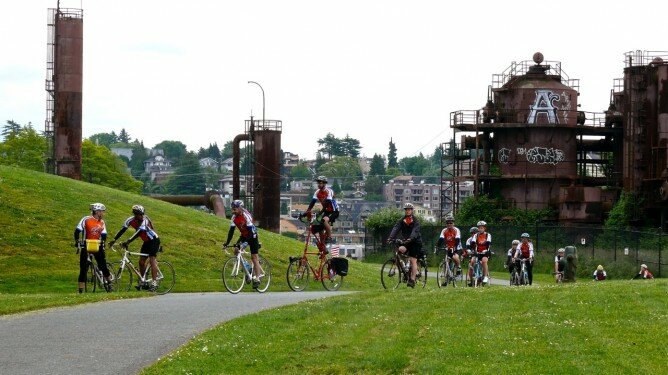Portland Greenway boosters Greg Raisman and Mark Lear were in Seattle recently to introduce the curious to this less-contentious form of transportation infrastructure. Seattle City Council’s Sally Bagshaw told the 70 people packed into the event that the time for greenways is now:
What I want to do–and as a member of your city council, what I am pledging to do–is to make sure that these neighborhood greenways become as real as what Portland has done. It is really my goal for my next few years while I am on the council.
It’s a timely pledge. Seattle Bike Blog reports on the finding from the annual American Communities Survey, conducted by the U.S. Census, that Seattle is in second place among major U.S. cities when it comes to the percentage of population who bike to work.
“Between 2005 and 2010, the percentage of people commuting by bike in Seattle increased 57 percent,” writes Tom Fucoloro–in absolute numbers, some 22,000 people (out of Seattle’s 610,000) chose bikes as their primary mode of work commuting in 2010.
On the one hand, 3.6 percent is a small slice of the commuter pie, but already the need to provide safe, effective bike infrastructure has strained Seattle civility. The “war on cars” meme may be talk-radio fodder, but it also arises from the zero-sum game of asphalt footprints. When Eugene rolls out its roomy bike lanes, it’s pretty easy to see that the street is now a single lane, one-way, for cars.
Greenways, by contrast, have an overall goal of increasing safety for everyone on neighborhood streets. No homeowner wants to see a harried commuter drag-racing down their street to save a few minutes of stop lights. The twin goals of calming traffic to 20 mph, and letting bikes and pedestrians circulate freely, tends to make everyone happy. As Bagshaw put it:
If we recognize that the system has to work for all of us…this isn’t about bicycles, this is about safety for all of us. And I knowThe Stranger last week had written something last week about declaring war on cars. And I think that’s just the wrong metaphor for us. The metaphor ought to be safety for all of us–whether we’re walking, whether we’re riding our bike, whether we’re driving our car or a truck or a scooter, that we all have a safe place to be.
As the recap of the presentation argues, “Traffic safety research in cities worldwide validates Portland’s experience: making streets safer for walking and bicycling ultimately makes them safer for driving. Through Portland’s safe streets policies for bicycles and pedestrians, their overall traffic fatality rate is falling 6 times faster than the rest of the United States.”
Last, but certainly not least, is the relative cost of greenways compared to more gold-plated bike infrastructure. Raisman and Lear quote a mile of greenway costing $250,000 while a mile of separated cycle track might climb toward $3 million. Given the fact that greenways are built from local streets, which make up about 70 percent of Portland’s road network, there just aren’t that many places they can’t take you.
It’s great to have the Council’s Bagshaw and O’Brien on board, but where is the rest of the Council? Where is Transportation Committee head Tom Rasmussen? Where is public safety advocate Tim Burgess? Where is Nick Licata, who made pedestrian safety a crusade following the death of Council aide Tatsuo Nakata, run down in the street? Seattle is known as a city of neighborhoods–sometimes to our chagrin–but increasing neighborhood safety with a low-cost, easy-to-implement network of greenways would seem to be an easy political win.
UPDATE: Sally Bagshaw wrote in via the comments section to emphasize that the Council is in support of greenways:
One important correction! Seattle Councilmembers ARE supportive of our Neighborhood Greenway concepts. You can make a difference by letting them know how important Greenways are to YOU and our growing transportation network for everyone including drivers pedestrians and bicyclists. Councilmembers — and the mayor — are our allies in this effort. The pressure should be on making Greenways a high priority. Please contact them as well as SDOT Director Peter Hahn and urge them to make Greenways part of our vision THIS YEAR for a safe and healthy city.
That said, the rest of the Council has been remarkably successful at keeping their support from showing up on Google searches. Here’s Sally Bagshaw + greenways. Now, here’s Tom Rasmussen + greenways. Not much visibility on the issue. Contact information for the City Council is here. SDOT contacts are here.
